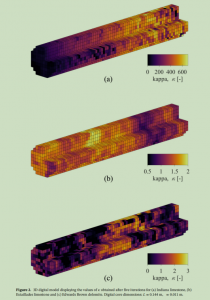Simulating Core Floods in Heterogeneous Sandstone and Carbonate Rocks
Abstract
The characterization of multiphase flow properties is essential for predicting large-scale fluid behavior in the subsurface. Insufficient representation of small-scale heterogeneities has been identified as a major gap in conventional reservoir simulation workflows. We systematically evaluated the workflow developed by Jackson et al. (2018), for use on rocks with complex porosity and capillary heterogeneities. The workflow characterizes capillary heterogeneity at the millimeter scale. The method is a numerical history match of a coreflood experiment with the 3D saturation distribution as a matching target and the capillary pressure characteristics as a fitting parameter. Coreflood experimental datasets of five rock cores with distinct heterogeneities were analyzed: two sandstones and three carbonates.
The sandstones exhibit laminar heterogeneities. The carbonates have isotropic heterogeneities at a range of length scales. We found that the success of the workflow is primarily governed by the extent to which heterogeneous structures are resolved in the X-ray imagery. The performance of the characterization workflow systematically improved with increasing characteristic length scales of heterogeneities. Using the validated models, we investigated the flow rate dependency of the upscaled relative permeability. The findings showed that the isotropic heterogeneity in the carbonate sample resulted in non-monotonic behavior; initially the relative permeability increased, and then subsequently decreased with increasing flow rate. The work underscores the importance of capturing small-scale heterogeneities in characterizing subsurface fluid flows, as well as the challenges in doing so.
Simulator: IMEX


